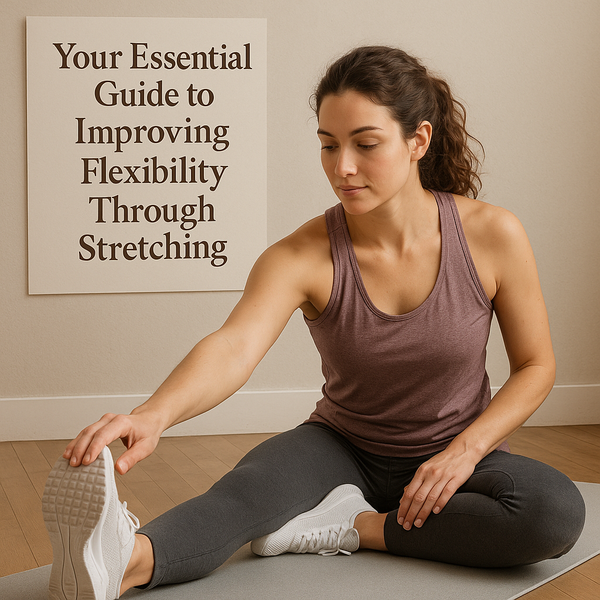
Stretching is often overlooked in fitness routines, yet it plays a crucial role in maintaining a healthy, active lifestyle. It's more than just touching your toes; it's about improving your body's range of motion, preventing injuries, and enhancing overall physical performance. Incorporating a regular stretching practice can lead to significant improvements in how your body feels and moves day-to-day, making activities easier and more enjoyable.
Understanding Flexibility and Why It Matters
Flexibility refers to the absolute range of movement in a joint or series of joints that is attainable in a moment. It's influenced by muscle length, joint structure, and the elasticity of connective tissues like tendons and ligaments. While some people are naturally more flexible than others, everyone can improve their flexibility through consistent stretching. Why is flexibility important? Improved flexibility can help reduce muscle stiffness and tension, increase your range of motion, and even enhance your athletic performance. It can also play a key role in preventing injuries by preparing muscles for activity and improving balance and coordination. Additionally, better flexibility can contribute to improved posture, helping to alleviate common aches and pains associated with sedentary lifestyles.
Types of Stretching Explained
Not all stretches are created equal. There are several types of stretching, each with its own benefits and best uses:
Static Stretching: This is perhaps the most common type. It involves holding a stretch position for a period, typically 30 seconds or more. Static stretching is best performed when muscles are warm, such as after a workout. Examples include holding a hamstring stretch or a triceps stretch.
Dynamic Stretching: This involves controlled movements that take your joints through their full range of motion. Dynamic stretches are excellent for warming up before exercise as they prepare muscles for activity. Examples include leg swings, arm circles, and torso twists.
Proprioceptive Neuromuscular Facilitation (PNF) Stretching: This technique often involves a combination of passive stretching and isometric contractions. It typically requires a partner and is effective for increasing range of motion, though it's often used in rehabilitation or advanced training settings.
Ballistic Stretching: This type uses bouncing or jerky movements to push the body beyond its normal range of motion. It's generally not recommended for most people due to the increased risk of injury, as it can trigger the stretch reflex, causing muscles to contract rather than lengthen.
For general flexibility improvement and injury prevention, static and dynamic stretching are the most widely recommended types for daily routines.
Building Your Flexibility Routine
Creating a consistent stretching routine is key to seeing results. Aim to stretch most days of the week, if possible. Here’s how you can structure your routine:
When to Stretch: Dynamic stretching is ideal as part of your warm-up before any physical activity. Static stretching is best performed after your workout when your muscles are warm and pliable. You can also perform static stretches on rest days to maintain and improve flexibility.
How Long to Hold: For static stretches, hold each stretch for 30-60 seconds, repeating 2-3 times. Focus on gentle tension, not pain. For dynamic stretches, perform 10-15 repetitions of each movement.
Which Stretches to Include: Focus on major muscle groups that tend to get tight, such as hamstrings, quadriceps, hip flexors, chest, shoulders, and upper back. Include stretches that target these areas. Simple stretches like hamstring stretches, quad stretches, calf stretches, chest stretches, and shoulder stretches are good starting points.
Consistency is Crucial: Like any fitness goal, improving flexibility takes time and consistency. Even short, regular stretching sessions are more effective than infrequent, long ones.
Tips for Effective and Safe Stretching
To get the most out of your stretching and avoid injury, keep these tips in mind:
Warm Up First: Never stretch cold muscles. Do 5-10 minutes of light cardio like jogging in place or jumping jacks before stretching, especially before static stretches.
Listen to Your Body: Stretch to the point of gentle tension, not pain. If you feel sharp or intense pain, ease off. Pushing too hard can cause injury.
Breathe Deeply: Use your breath to help you relax into stretches. Inhale before the stretch and exhale as you deepen it, holding the stretch while breathing steadily.
Be Patient: Flexibility gains are gradual. Don't get discouraged if you don't see results immediately. Keep at it consistently.
Use Proper Form: Research or consult a fitness professional to ensure you are performing stretches correctly to effectively target the intended muscles and avoid strain.
Hold Still During Static Stretches: Avoid bouncing movements during static stretches, as this can activate the stretch reflex and potentially cause muscle tears.
Consider Using Props: Straps, blocks, or chairs can help you achieve deeper stretches or modify them if you have limited flexibility.
Flexibility for Specific Needs
Stretching can be tailored to specific activities or needs. For example, runners might focus on hamstring, calf, and hip flexor stretches. People with desk jobs might prioritize chest, shoulder, and upper back stretches to counteract the effects of prolonged sitting. Athletes in sports requiring specific ranges of motion, like gymnastics or swimming, will incorporate targeted flexibility work into their training. Even simple daily activities like reaching for something on a high shelf or bending down to tie your shoes become easier with improved flexibility.
Incorporating a consistent stretching routine into your life is a powerful way to invest in your physical well-being. It’s not about becoming a contortionist, but about improving your body's functional movement capabilities, reducing the risk of common injuries, and simply feeling more comfortable and capable in your own skin. Start small, be consistent, listen to your body, and enjoy the journey towards a more flexible you.

